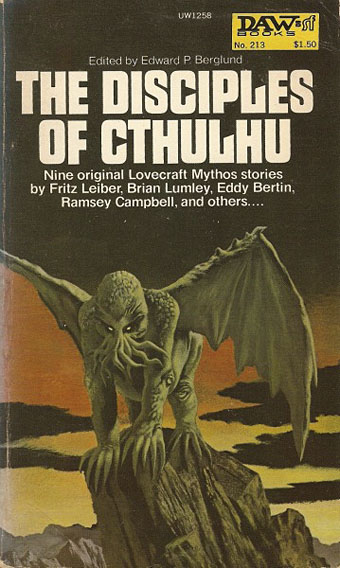
The Disciples of Cthulhu (1976).
A disagreement I have with the burgeoning world of Lovecraft art is the relentless focus on monsters—and I say this in a week when I’ve been working on a new commission of exactly this: six pictures of Lovecraftian creatures. Lovecraft famously emphasised atmosphere as the paramount ingredient in a weird story, and atmosphere in his fiction is often generated by his descriptions of landscape and architecture; Angela Carter’s insightful essay in the George Hay Necronomicon (1978) was entitled Lovecraft and Landscape. Architecture often receives considerable attention in the stories: The Call of Cthulhu, The Dreams in the Witch House, The Haunter of the Dark, and At the Mountains of Madness all concern invented (or reimagined) architectural settings. Given this, you’d expect architecture to be more represented in Lovecraft art but this is seldom the case. When it comes to Cthulhu, a creature whose myriad representations must be reaching some kind of critical mass, artists will lavish great attention on tentacles, claws and flourished wings but the Cyclopean stones of R’lyeh are invariably reduced to a tentative backdrop.
I mostri all’angolo della strada (The Monsters on the Street Corner, 1966).
Hence the attraction of the wraparound cover by Karel Thole for I mostri all’angolo della strada, a Lovecraft story collection with one of the few cover designs I’ve seen that attempts to communicate anything of the writer’s preoccupations with angled space. Thole was a very prolific Dutch artist, producing many covers for Italian publisher Mondadori, and painting covers for Mondadori’s SF magazine, Urania, for over 20 years. The first paintings of Cthulhu I saw were those by Thole (above) and Bruce Pennington in Franz Rottensteiner’s The Fantasy Book (1978); Thole’s monster doesn’t have the required scale (and Pennington’s cover is a favourite) but for me it still carries a Proustian charge. The art for I mostri all’angolo della strada was featured in The Cosmical Horror of HP Lovecraft (1991), one of the first attempts to anthologise Lovecraft-related illustration past and present. The book contains many excellent reprints together with dubious material from European comics. Thole’s street scene—a curious combination of Escher, De Chirico and Art Nouveau—stood out among page after page of slavering abominations. I’d like to see more art that follows this direction; less of the monsters, more of the monstrous architecture.
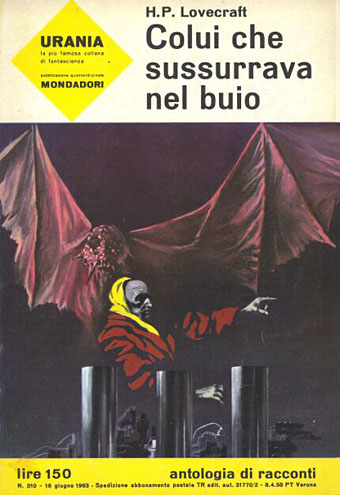
Colui che sussurrava nel buio (The Whisperer in Darkness, 1963).
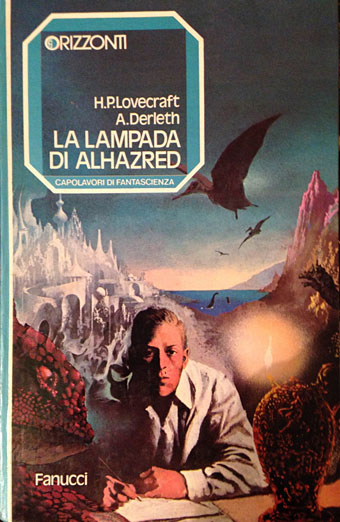
La lampada di Alhazred (1977).
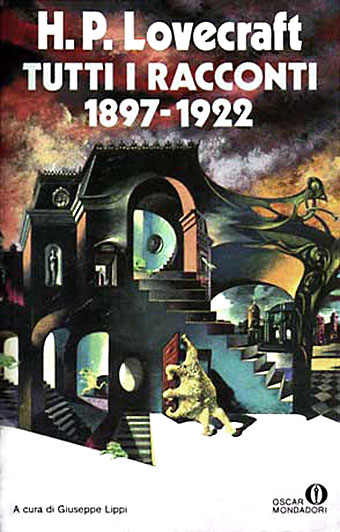
Elsewhere on { feuilleton }
• The illustrators archive
• The Lovecraft archive

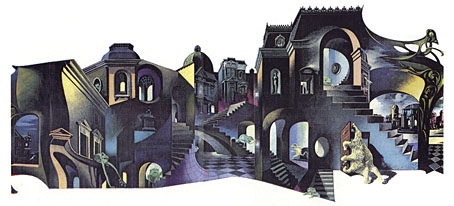
Thole’s 1966 wraparound design is one of the finest Lovecraftian designs *ever*. There is much work to do in showcasing international art such as this which is superior to the ‘rabble’–thanks for being The Gateway, John.
Excellent points. And this is why the movies turn out to be mostly no good. Lack of Lovecraftian atmosphere. If they don’t get that then the movie makers are wasting their time.
My favorite Lovecrafty movie (Lovecrafty being defined as a movie that captures his spirit without being an adaptation of his work) is the 1967 Hammer adaptation of QUATERMASS AND THE PIT. I actually prefer it to the miniseries.
I think that Borges picks up on this aspect in ‘There are more things’ and takes it a step further or perhaps even parodies it when you are prompted to visualise the creature not through the architecture of the house the protagonist enters but by the furniture it contains. Love the Thole cover by the way; it conjures up Portmerion and the Bates Motel all at once.
Thole’s street scene—a curious combination of Escher, De Chirico and Art Nouveau
I found myself imagining some of Dr Seuss’ artwork as a Lovecraft illustration.
John I agree with you 100%. Lovecraft is a master of atmosphere. His descriptions of wandering dark cities, underground vaulted rooms and empty rooms fare terrifying. Wandering in an empty house and searching for a “scratching” behind the walls freezes the reader’s blood. I think the monsters are the icing on the cake.
Did you ever do an article on Alfred Kubin’s book “The Other Side?” I assume you have read it. Besides being a wonderful artist, his book reflects the 20th century’s penchant for chaos. A book also filled with an atmosphere of doom and dread.
Ah, Franz Rottensteiner’s The Fantasy Book! Many happy hours leafing through that (and his SF book).
As a side note; I would say the best Lovecraftian film is the original ‘Ghostbusters’.
Stephen: Yes, there are similarities between Kneale and Lovecraft although Kneale–who was often touchy about these matters–would probably have dismissed the idea. I’ve always liked John Carpenter’s The Thing for its close relationship to At the Mountains of Madness.
Modzilla: Thole’s painting reminds me of Borges too, somewhat inevitably when the Borges is a favourite story.
Richard: Very familiar with Kubin’s novel but I’ve never written about it. Very strange and disturbing book. Jeff V wrote about it earlier this year:
http://weirdfictionreview.com/2015/01/celebrating-alfred-kubins-1908-novel-side/
Nick: The cartoon series had a story entitled The Collect Call of Cathulhu.